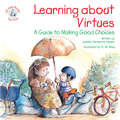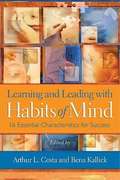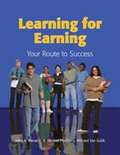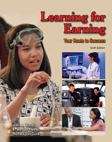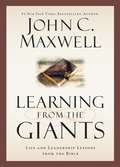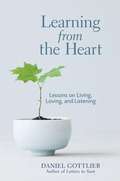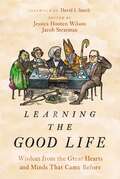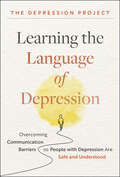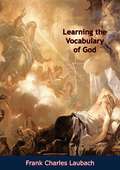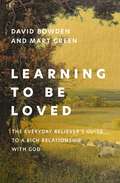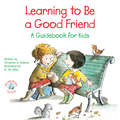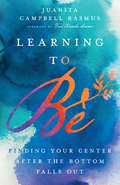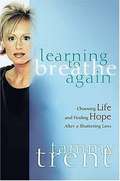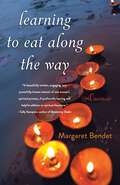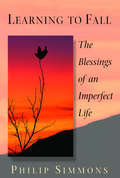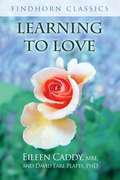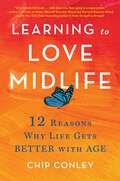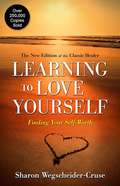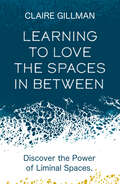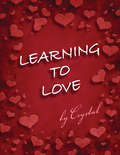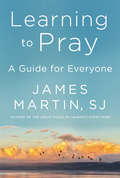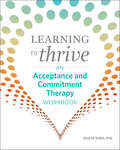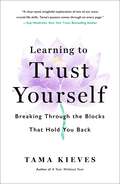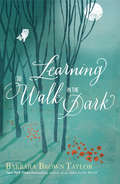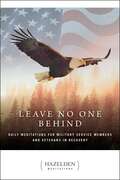- Table View
- List View
Learning about Virtues: A Guide to Making Good Choices
by R. W. Alley Juliette Garesché DagesThis book introduces the concept and basic vocabulary of virtues. It helps children to recognize and label the behaviors which they are striving to develop. When a child attains a virtue, that trait will become almost habitual for them. But it isn't always easy. Life produces many challenges, and today's culture often seems to oppose virtue. However, through faith, example, and practicing individual virtues, a child will keeping growing through adulthood, planting more seeds of God's goodness along the way. We hope you have fun introducing virtues to the children in your life. This book is just the start. Be creative, and don't forget to catch your children being good! Praise their every effort toward goodness and God-likeness.
Learning and Leading With Habits of Mind: 16 Essential Characteristics for Success
by Arthur L. Costa Bena KallickIn Learning and Leading with Habits of Mind, noted educators Arthur L. Costa and Bena Kallick present a comprehensive guide to shaping schools around Habits of Mind. The habits are a repertoire of behaviors that help students and teachers successfully navigate the various challenges and problems they encounter in the classroom and in everyday life. The Habits of Mind include: Persisting, Managing impulsivity, Listening with understanding and empathy, Thinking flexibly, Thinking about thinking (metacognition), Striving for accuracy, Questioning and posing problems, Applying past knowledge to new situations, Thinking and communicating with clarity and precision, Gathering data through all senses, Creating, imagining, innovating, Responding with wonderment and awe, Taking responsible risks, Finding humor, Thinking interdependently, Remaining open to continuous learning.
Learning for Earning: Your Route to Success
by John A. Wanat E. Weston Pfeiffer Richard Van GulikFocuses on helping students understand self first, then making a career match. Identifies the workplace know-how needed for success on the job, as determined by the Secretary's Commission on Achieving Necessary Skills (SCANS).
Learning for Earning: Your Route to Success, 6th Edition
by John A. Wanat E. Weston Pfeiffer Richard Van GulikLearning for Earning presents the skills students need to succeed in school, on the job, and on their own. Teacher's Wraparound Edition provides teaching aids in the page margins for reviewing and reinforcing text content plus challenging activities that extend learning. The text includes a running glossary to highlight new terms presented in the chapters.
Learning from the Giants: Life and Leadership Lessons from the Bible (Giants of the Bible)
by John C. MaxwellIf you could spend a few minutes with the giants of faith in the Old Testament in person, what lessons would they share with you? In LEARNING FROM THE GIANTS John C. Maxwell draws on fifty years of studying the Bible to share the stories of Elijah, Elisha, Job, Jacob, Deborah, Isaiah, Jonah, Joshua and Daniel. These people fought and won epic battles, served kings, and endured great hardships for God to come out on the other side transformed through His grace. Through them Maxwell explores timeless lessons we can learn about leadership, ourselves, and our relationship with God.
Learning from the Heart: Lessons on Living, Loving, and Listening
by Daniel GottliebIn the nearly 30 years since the accident that made radio personality and columnist Dan Gottlieb a quadriplegic, he developed a finely-tuned quality of awareness that most people never achieve: he became an outsider among us--"like a foreign correspondent," as he puts it. From that vantage point, he has acutely observed the way people act, think, feel, and live--in short, he studied and learned exactly what it means to be human. Here, Dan shares his insights, written with humor, honesty, a gift for storytelling, and breathtaking compassion. Learning from the Heart looks at what divides as well as unites us, including the problems of family life; difficulties confronting today's parents; challenges faced by the disabled and the aging; and issues of injustice that affect the way we understand the world and our lives. Although Dan is now speaking directly to the reader, rather than to his own family, you'll recognize the distinctive voice and format that caused an outpouring of e-mail from fans of Letters to Sam: short anecdotal chapters rich in wisdom, generously revealing and deeply personal, and resonating with universal truths.
Learning the Good Life: Wisdom from the Great Hearts and Minds That Came Before
by Jacob Stratman Jessica Hooten WilsonDiscover the Good Life as you learn from the wise voices of the past.We've lost ourselves. Disconnected from the past and uncertain about the future, we are anxious about what our lives will be and troubled by a nagging sense of meaninglessness. Adrift in the world, many Christians have their identity completely wrapped up in work, and their definition of the "good life" is financial success. Fewer of are staying committed to the Christian faith, finding it difficult to reconcile their experience with their longings and desires. With so much uncertainty, where can we find a true vision of "the Good Life"?Learning the Good Life speaks to this malaise with a curated collection of voices from the past, inviting Christians into an ages-old dialogue with some of history's wisest and most reflective minds. Featuring thought-provoking writings from a diverse lineup of over 35 writers and thinkers:From the classic—including Confucius, Augustine, Sor Juana Inés de la Cruz, Henry David Thoreau, and Frederick Douglass;To the modern—including W.E.B. DuBois, Flannery O'Connor, T.S. Eliot, and Simone Weil;To the contemporary—including Wendell Berry, David Foster Wallace, and Marilynne Robinson.Together these sages, writers, philosophers, and poets address important issues such as virtue, beauty, community, wonder, suffering, and meaning.Each of these texts are introduced by experts from a variety of Christian colleges and universities to help provide a richer narrative in which Christians can participate. Each text is also accompanied by discussion questions to provoke further thought and contemplation and to facilitate discussion when used in groups.Learning the Good Life is ideal for any Christian seeking a deeper connection to the wisdom of the past and wanting a more cohesive vision of the good life. Though not all these writers were themselves Christians, they all have a message for you. All of them are calling you to die to yourself, to your habits of indulgence, to your pride and ambition—and to dedicate your time to learning, thinking, and loving.
Learning the Language of Depression: Overcoming Communication Barriers so People with Depression Are Safe and Understood
by The Depression ProjectIn order for people with depression to feel safe and understood, it's essential to overcome depression's "language barrier" As The Depression Project hears every single day from members of their 3,000,000+ person social media community, a “language barrier” often exists between people with depression and those around them — in the sense that many words, everyday expressions and non-verbal forms of communication can take on a vastly different meaning than they otherwise would when they are coming from someone who has depression. And, as The Depression Project also continuously hears, this “language barrier” can result in people with depression being judged and criticized; having conflict with their loved ones; feeling alone, misunderstood and unsupported; and being more at risk of attempting suicide. Consequently, in order to overcome this “language barrier” and therefore help people with depression feel safe, understood, supported and much better as a result. This book will: Explain what people with depression are actually going through when they say “I have depression” (it is much more than sadness); when they say “I'm fine” (very often they are not); when they say “I'm tired” (“depression tiredness” is very different from “normal tiredness”); when they say “I can't” (which is often misinterpreted as “I won't”, and as that person with depression just being “lazy”); and when they say other commonly spoken phrases that are often misunderstood by people who have never experienced depression themselves before. Share a wide variety of suggestions to help make it easier for people with depression to put what they are going through into words. Highlight the language people with depression often use that can indicate they are feeling suicidal (which tragically, is often ignored, dismissed or not picked up on by the people around them). Look at depression's “facial language barrier”, and explain what people with depression are often actually going through when they smile, avoid eye contact, have muted facial expressions, or look tired or frustrated (when a person has depression, these facial expressions and interactions can often mean something very, very different than they otherwise would). Address depression's “touch language barrier” by clarifying the reasons why depression can cause someone to be much less tactile and physically intimate than they would otherwise be, and by explaining the steps that can be taken to help prevent this lack of physical intimacy from spiraling into long-term relationship problems. Learning The Language Of Depression is an ideal book for people with depression who would like some help communicating what they are going through so that they can be better understood, as well as friends and family of someone with depression who would like to better understand their loved one and effectively support them.
Learning the Vocabulary of God: A Spiritual Diary
by Frank Charles LaubachFrank Charles Laubach was an Evangelical Christian missionary and mystic known as "The Apostle to the Illiterates." It was a daily record of an effort to hear God's instructions, minute by minute, and to carry them out in a new, creative field which was far beyond anything the author had undertaken.-Print ed.
Learning to Be Loved: The Everyday Believer's Guide to a Rich Relationship with God
by David Bowden Mart GreenAre you feeling spiritually stuck? Release that frustration and discover a more natural way to relate to God in this biblically grounded, transformative book about how our passionate and creative God offers us gateways--that are already in our lives--to draw us closer to him.What if intimacy with God doesn't begin with us knocking at God's door but with God knocking down ours? In Learning to Be Loved, author and Spoken Gospel CEO David Bowden and Hobby Lobby's Mart Green remind us that spiritual growth starts not with our giving but with our receiving.This unique and freeing invitation to respond to God's initiative explores:Common misconceptions that can hold back our spiritual growthPractical "doors"--such as dreams, wounds, and generosity--that are already in your life as ways for you to organically connect with God according to how he has made youA vision of the Christian life that isn't about doing the right things but learning how receiving God's love moves us toward the right thingsPractices to help you partner with God in living your own spiritual story rather than always comparing yourself to other peopleCombining David's careful study and poetic voice with Mart's decades of wisdom about the simplicity of a life lived toward God, Learning to Be Loved unites biblical rigor and personal experience to show that intimacy with God isn't based on our ability to connect with him--but on all the ways he is constantly connecting with us.
Learning to Be a Good Friend
by R. W. Alley Christine A AdamsLearning to Be a Good Friend allows adults to show kids how to cultivate friendship. It discusses behaviors that foster friendships, as well as those that drive friends away. It illustrates the pitfalls of peer pressure, and what to do when you can't find a friend or have lost your best friend.
Learning to Be: Finding Your Center After the Bottom Falls Out
by Juanita Campbell RasmusIt felt as though every nerve in my body was popping. Imagine large strong hands slowly applying pressure while breaking a family-size package of uncooked, dry spaghetti. I was the spaghetti. Breaking down one piece at a time. This is how Juanita Rasmus begins the wise, frank, and witty account of what she later called "The Crash" and what her counselor labeled "a major depressive episode." This experience landed Juanita, a busy pastor, mother, and community leader, in bed. In addition to exhaustion and depression, on the spiritual front she experienced a dark night of the soul. When everything in her life finally came to a stop, she found that she had to learn to be—with herself and with God—all over again. Pastor Juanita writes from her life with kind attention to the life of the reader. She offers both practical and spiritual insights but never pat answers. If you are longing for a trustworthy companion through dark days, this book is here for you. Each chapter includes life-giving spiritual practices to help you discover your own new ways of being.
Learning to Breathe Again: Choosing life and Finding Hope After a Shattering Loss
by Tammy TrentThis is the story of one young woman who copes with the devastating loss of her best friend and husband. She points to our true help, Jesus Christ.
Learning to Eat Along the Way: A Memoir
by Margaret BendetWhen Margaret Bendet is told to interview an Indian holy man, she thinks it&’s just another assignment—but after speaking with him, she decides to accompany him back to his ashram, hoping to find enlightenment. In Learning to Eat Along the Way, Bendet enters a world that many have wondered about but few have seen: the milieu of a spiritual master. Subtle experiences prompt her to embark on this journey with &“the swami,&” as she calls the holy man, and to enter into the ashram—but once there, she deals with a host of psychological issues, including intense infatuation and life-threatening anorexia. &“Each person comes to the ashram in order to receive something,&” the swami tells her, &“something to take with you when you leave—something you can eat along the way.&” Bendet finds this to be truer than she could have imagined. Clear-eyed and candid, Learning to Eat Along the Way is an honest and often surprising account of one woman&’s experience with spiritual work.
Learning to Fall: The Blessings of an Imperfect Life
by Philip SimmonsA &“reflective, eloquent [and] inspiringly written&” (The New York Times) collection of essays about learning to live richly in the face of loss &“Astonishing . . . sometimes heartbreaking . . . sometimes hilarious.&”—The Boston Globe WINNER OF THE BOOKS FOR A BETTER LIFE AWARD&’S BEST SPIRITUAL BOOKPhilip Simmons was just thirty-five years old in 1993 when he learned that he had ALS, or Lou Gehrig&’s disease, and was told he had less than five years to live. As a young husband and father, and at the start of a promising literary career, he suddenly had to learn the art of dying. Nine years later, he succeeded, against the odds, in learning the art of living. In this surprisingly joyous and spirit-renewing book, he chronicles his search for peace and his deepening relationship with the mystery of everyday life. From our first faltering steps, Simmons says, we may fall into disappointment or grief, fall into or out of love, fall from youth or health. And though we have little choice as to the timing or means of our descent, we may, as he affirms, &“fall with grace, to grace.&”With humor, hard-earned wisdom, and a keen eye for life&’s lessons—whether drawn from great poetry or visits to the town dump—Simmons shares his discovery that even at times of great sorrow we may find profound freedom. And by sharing the wonder of his daily life, he offers us the gift of connecting more deeply and joyously with our own.
Learning to Love
by Eileen Caddy David Earl PlattsAn insightful guide for consciously bringing compassion and love into your life • Explores feelings, attitudes, beliefs, and past experiences that block us from loving and receiving love • Includes deceptively simple yet profound exercises, meditations, and visualizations to support the exploration of your inner world • Explains how these principles and techniques originated in Roberto Assagioli’s system of psychosynthesis, enriched by the Findhorn experience of living in community Every person is born with the capacity to love. Over time, however, many of us have built barriers within ourselves as a reaction to painful experiences, and following these, we often develop fears, beliefs, and behaviors that keep these barriers firmly in place. The primary lesson in life is to learn to love, and this starts right on our doorstep. Often it is self-doubt and feelings of unworthiness that hold us back from experiencing all the love around us. Only when we start to love and accept ourselves with all that we are can we love others freely and fully. Learning to love requires an intention to change and a willingness to take action. Once we understand how to work with our doubts and fears and learn how to change our beliefs and behavior, our barriers will melt away and we spontaneously open up to connect deeply and harmoniously with the full flow of the river of life. In this simple yet insightful guide, Eileen Caddy and David Earl Platts detail the down-to-earth practicalities of exploring feelings, attitudes, beliefs, and past experiences that block us from loving and from receiving love. They show how bringing more love into our lives is not a mystery but often a journey back to ourselves and our core values. The authors examine the feelings of acceptance, trust, forgiveness, respect, opening up, and taking risks, among others, within a framework of compassionate understanding and non-judgment. Deceptively simple yet profound exercises, meditations, and visualizations support the reader in examining their inner world and implementing these vital concepts into their lives. The teachings in the book are based on popular workshops that Eileen, co-founder of the Findhorn Foundation Community, and David facilitated for years in and outside Findhorn. Many of the underlying principles and techniques originate in the system of psychosynthesis, devised by Roberto Assagioli. Learning to Love invites you to make a free and informed choice to bring more love into your life, and then helps you implement this choice step-by-step with confidence and joy.
Learning to Love Midlife: 12 Reasons Why Life Gets Better with Age
by Chip ConleyNew York Times bestselling author and co-founder/CEO of The Modern Elder Academy inspires readers to embrace midlife as a time of joy in this &“clear blueprint for creating the lives we want&” (Gretchen Rubin) The midlife crisis is the butt of so many jokes, but this long-derided life stage has an upside. What if we could reframe our thinking about the natural transition of midlife not as a crisis, but as a chrysalis—a time when something profound awakens in us, as we shed our skin, spread our wings, and pollinate our wisdom to the world? In Learning to Love Midlife, Chip Conley offers an alternative narrative to the way we commonly think of our 40s, 50s and 60s. Drawing on the latest social science research, inspiring stories, and timeless wisdom, he reveals 12 reasons why life gets better with age. They include: The relief of &“my body doesn&’t define me:&” We finally grow comfortable in our own skin Stepping off the treadmill: We redefine what a successful life looks like The &“Great Midlife Edit:&” We let go of our emotional baggage, mindsets, and obligations that no longer serve us Growing whole: We begin to feel a part of something bigger than ourselves No matter where you are in your midlife journey, this perspective‑shifting guide will inspire you to find joy, purpose and success in the years that lie ahead—and how those years can be your best ones yet.
Learning to Love Yourself: Finding Your Self-Worth
by Sharon Wegscheider-CruseWe all come into this world full of promise and possibility. For some, when born into a healthy and highly functional family, the journey is quite easy, with guideposts and directions given freely. However, that is a very small population of people. Most of us were born into families that were in their own way struggling for independence, accomplishment, safety or security. For the millions of people who grew up in painful families, whether by absent parents, abusive parents, or those who were ill-equipped, noted therapist Sharon Wegscheider-Cruse shows that they do not have to follow a family tradition of compulsion or addiction. In the revised edition of the classic Learning to Love Yourself, Wegscheider-Cruse explains that it is possible to create our own self-worth at any time in our lives, even as adults. She guides readers on a journey to greater self-worth, explaining how to eliminate toxic self-defeating messages, how to choose healthier, new perspectives, and how to reinvent yourself each day open to a world of possibilities.
Learning to Love the Spaces in Between: Discover the Power of Liminal Spaces
by Claire GillmanThe word liminal comes from the Latin word 'limen', meaning threshold. In its literal sense, a threshold is a doorway. 'Liminal' is often used to describe the gateway between two stages.A liminal space can be a metaphysical state – the place between sleep and wakefulness, between life and death where consciousness is altered, the transition period between one life event and the next; or it can be a physical space – the coastline between sea and shore, an empty art gallery, or the moment just before it rains.In an age where so much importance is placed on facts and explanations, the feelings we derive from liminal 'unknown' spaces can disrupt our equilibrium. Yet these 'spaces in between' are often where insight, creativity and inspiration are found.Here, life-long liminal explorer and journalist Claire Gillman helps us learn and grow through our experiences of liminality. Featuring contributions from leading luminaries including Bruce Parry, Caroline Myss, Dr Eben Alexander, Neale Donald Walsch, Phyllis Curott, Yasmin Boland, Dr Robert Holden, Satish Kumar, Dr Mike Dow and Felicity Warner, Claire shows us how we can navigate and embrace liminal experiences to enhance our wellbeing and understanding of the world.
Learning to Love: A Journey To Loving Yourself
by Crystal ThomasFilled with affirmations, and thought-provoking questions, "Learning to Love" combines the author's personal experience of discovering the importance of putting time and energy into loving ourselves first with her professional knowledge of the crucial part that relationships play in every aspect of our lives. This guidebook helps us understand ourselves and the power that we have in creating our lives every moment of every day.
Learning to Pray: A Guide for Everyone
by James MartinOne of America’s most beloved spiritual leaders and the New York Times bestselling author of The Jesuit Guide to (Almost) Everything and Jesus: A Pilgrimage teaches anyone to converse with God in this comprehensive guide to prayer.In The Jesuit Guide to (Almost) Everything, Father James Martin included a chapter on communicating with God. Now, he expands those thoughts in this profound and practical handbook. Learning to Pray explains what prayer is, what to expect from praying, how to do it, and how it can transform us when we make it a regular practice in our lives. A trusted guide walking beside us as we navigate our unique spiritual paths, Martin lays out the different styles and traditions of prayer throughout Christian history and invites us to experiment and discover which works best to feed our soul and build intimacy with our Creator. Father Martin makes clear there is not one secret formula for praying. But like any relationship, each person can discover the best style for building an intimate relationship with God, regardless of religion or denomination. Prayer, he teaches us, is open and accessible to anyone willing to open their heart.
Learning to Thrive: An Acceptance and Commitment Therapy Workbook
by Giulia SuroIt's time to ACT—Acceptance and Commitment Therapy made simple.Now Acceptance and Commitment Therapy (ACT) can be easy. Learning to Thrive simplifies this ordinarily complex self-acceptance therapy and helps you apply its action-oriented principles directly to different aspects of your life.Filled with straightforward and intuitive exercises, Learning to Thrive: An Acceptance and Commitment Therapy Workbook helps you stop thinking of your thoughts, feelings, and emotions as negative and start learning to understand and relate to them in a new way—so you can make meaningful changes to your life. Whether you're looking for ways to improve your personal life, work, or health, you'll find the tools and insights that can help you do it. It's time to get unstuck and start thriving!This Acceptance and Commitment Therapy workbook includes:A practical approach—Understand (and accept) yourself using a workbook that gives you the tools you need to make real, impactful changes.Solutions for everyday concerns—Apply the lessons of Acceptance and Commitment Therapy to specific parts of your life thanks to chapters focused around family, wellness, personal growth, and more.ACT made easy—Keep things simple with techniques written specifically for people new to Acceptance and Commitment Therapy—no psych textbooks needed.Discover how you can truly accept yourself and bring positive change to your life with Learning to Thrive: An Acceptance and Commitment Therapy Workbook.
Learning to Trust Yourself: Breaking Through the Blocks That Hold You Back
by Tama KievesA powerful guide to self-reliance, for anyone ready to unlock their inner genius and start living their most exceptional lifeIn a world riddled with conflict and doubt, trusting yourself can feel harder than ever – and self-trust is the foundation of happiness, self-confidence, and success.If you have ever talked yourself out of anything, let others convince you that something is impossible, or doubted your feelings or instincts – then this book is for you.Through her signature style of smart spitfire inspiration and candid personal stories, bestselling author, former Harvard lawyer, and leading-edge coach Tama Kieves teaches readers how to create their exceptional lives. Turn roadblocks into breakthroughs by learning how to trust your strength more than your doubt until it becomes the best habit of your lifetime.Says Tama, “Chase your inner genius all the way. Your way may be off the map. But it’s also off the charts!”
Learning to Walk in the Dark: Because God Often Shows Up At Night
by Barbara Brown TaylorFollow Barbara Brown Taylor on her journey to understand darkness, which takes her spelunking in unlit caves, learning to eat and cross the street as a blind person, discovering how "dark emotions" are prevented from seeing light from a psychiatrist, and rereading scripture to see all the times God shows up at night. With her characteristic charm and wisdom, Taylor is our guide through a spirituality of the nighttime, teaching us how to find God even in darkness, and giving us a way to let darkness teach us what we need to know.de through a spirituality of the nighttime, teaching us how to find our footing in times of uncertainty and giving us strength and hope to face all of life's challenging moments.
Leave No One Behind: Daily Meditations for Military Service Members and Veterans in Recovery (Hazelden Meditations)
by AnonymousOf the Americans who serve—and have served—in the United States Armed Forces, many struggle with alcoholism and addiction. What happens when the people who keep our country safe need saving? How do we fulfill our promise to leave no one behind? We show them there are service members who have been through similar circumstances, who can help them, and who might also need help. This book does just that.In this new meditation book, service members who are in recovery share their words of healing and hope in daily meditations. These people are in a class of their own—they know what they experienced, they know how their recovery has been affected by their service, they know how to help themselves . . . and they know how to help each other. The voices in this book are unique and will resonate with readers, providing insights, thoughts, and feelings only others who have served can understand and relate to. The same can be said of recovery: we look to the person on our left and the person on our right—and we leave no one behind.
